Today is the commemoration of St. Elisha, prophet, called also Eliseus. He was the disciple of Elijah (1 Kings 19:1-21). When Elijah was about to be taken up to heaven in the fiery chariot, Elisha asked for a double portion of his spirit. So great was God’s power to work miracles in him that even touching his corpse could heal (cf. Ecclesiasticus, 48, 152; Kings 13:20-21).
Maybe some of you would like to take a shot at his entry in the Martyrologium Romanum:
Die 14 Junii
Decimo octavo Kalendas iulii.1. Samariae seu Sebaste in Palestina, commemoratio sancti Elisei, qui, discipulus Eliae, propheta fuit in Israel tempore regis Ioram usque ad dies Ioas; etsi oracula non reliquit, tamen, miracula pro advenis patrando, salutem nuntiavit omnibus hominibus adfuturam.
Carmelites make much of St. Elisha, I suppose because of his connection to Elijah and that he sojourned on Mt. Carmel for a while. They have celebrated his feast since 1399. I found this prayer online, though I don’t have the Latin original to compare it with (from Carmelite Proper of the Liturgy of the Hours,” Institutum Carmelitanum, Rome: 1993). Perhaps one of you out there have the Latin version and will post it.
O God,
protector and redeemer of the human family,
whose wonders have been proclaimed through the wonders accomplished by your chosen prophets,
you have bestowed the spirit of Elijah on your prophet Elisha:
in your kindness grant us too
an increase in the gifts of the Holy Spirit
so that, living as prophets,
we will bear constant witness to your abiding presence and providence.
One of the things I think about right away when Elisha is mentioned is the older form of blessing Holy Water. Exorcised and blessed salt is used in the rite for blessing water.
Why Elisha? In 2 Kings 2, Elisha pours salt into the waters of the Jericho which were poison, and caused deaths and miscarriages. Also, in the rites of blessing water, the salt to be used is addressed personally as a creature of God when it is exorcised. NB: adjuro is a great verb meaning basically in later Latin “to conjure or adjure, to beg or entreat earnestly”. In the writings of North African Fathers such as Tertullian, Cyprian, and Lactantius it comes to mean “oblige by speaking” and is applied to exorcising demons and unclean spirits.
Exorcizo te, creatura salis, per Deum + vivum, per Deum + verum, per Deum + sanctum, per Deum, qui te per Eliseum Prophetam in aquam mitti jussit, ut sanaretur sterilitas aquae; ut efficiaris sal exorcizatum in salutem credentium; et sis omnibus sumentibus te sanitas animae et corporis; et effugiat, atque discedat a loco, in quo aspersum fueris, omnis phantasia et nequitia vel versutia diabolicae fraudis, omnisque spiritus immundus, adjuratus per eum qui venturus est judicare vivos et mortuos, et saeculum per ignem. R. Amen.
O you creature of salt, I purge you of all evil by the living + God, by the true + God, by the holy + God, who commanded by the Prophet Elisha that you be put into water in order that the sterility of the water would be healed: so that you might be rendered a purified salt for the salvation of believers, and so that you might be a healthiness of soul and body to all who consume you, and so that you may put to flight and drive out from a place in which you will have been scattered every phantom and wickedness, and cunning trap of diabolical deceit, and every unclean spirit be solemnly banished by command through Him Who shall come to judge the living and the dead, and the world by fire. R. Amen.
Priests ought to pray this way all the time.
Fathers! Elisha doesn’t want you to use wimpy prayers that are vague and uninteresting.
No joke! Mock Elisha and you might get mauled by bears. Ask those children in 2 Kings 2 what happens when you mock the prophet. You may recall that a bunch of little kids started to razz Elisha. He cursed them and a couple of female bears came out of the forest and tore them to bits.
Who can forget the famous stage direction at the end of Shakespeare’s The Winter’s Tale. III,iii.
“Exit, pursued by a bear.”
Apropos… one of you in regard to Elisha once posted a limerick in the comments. Antigonus is the pursued character in The Winter’s Tale.
As Antigonus kept a fell mandate,
And the rude boys blasphemed against Baldpate,
The truth is the same:
To obey or defame
Without reference to God makes one bear bait.
If memory serves, one of the writers who defends Shakespeare’s Catholicism (hardly to be questioned) make much of his hints and codes in The Winter’s Tale. It would be in one of these.
Clare Asquith’s Shadowplay: The Hidden Beliefs and Coded Politics of William Shakespeare. She over plays her hand once in while, but in the main the book is engaging and convincing.
Also, Joseph Pearce, mentioned above, has The Quest for Shakespeare
Also, there is a possibility that Shakespeare was in Rome and that he studied for the priesthood at what is now the Venerable English College.
Let’s have some images of bears tearing kids apart for mocking the prophet.
French 1463 Ms Douce 336 Bodl. lib
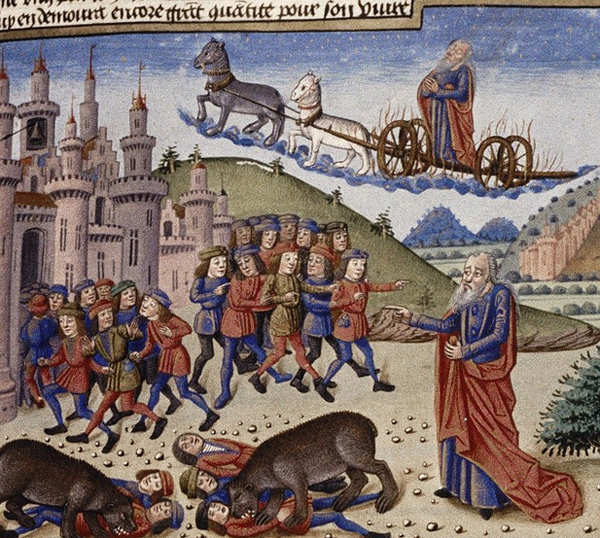
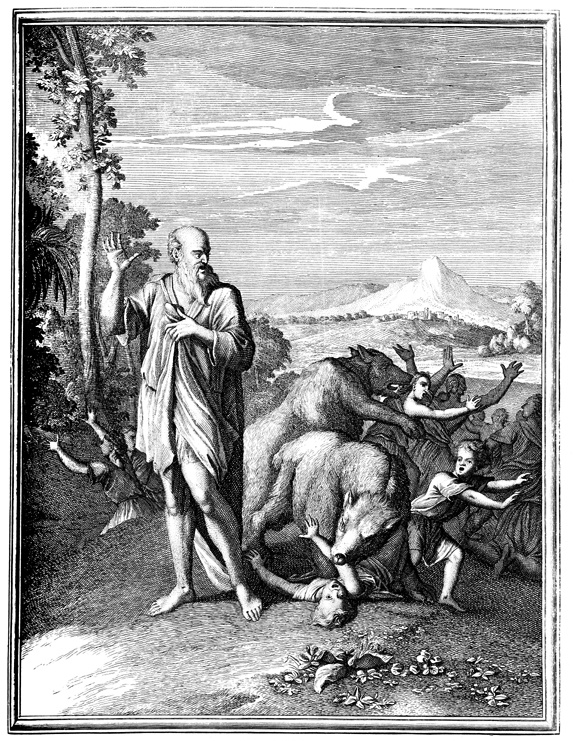
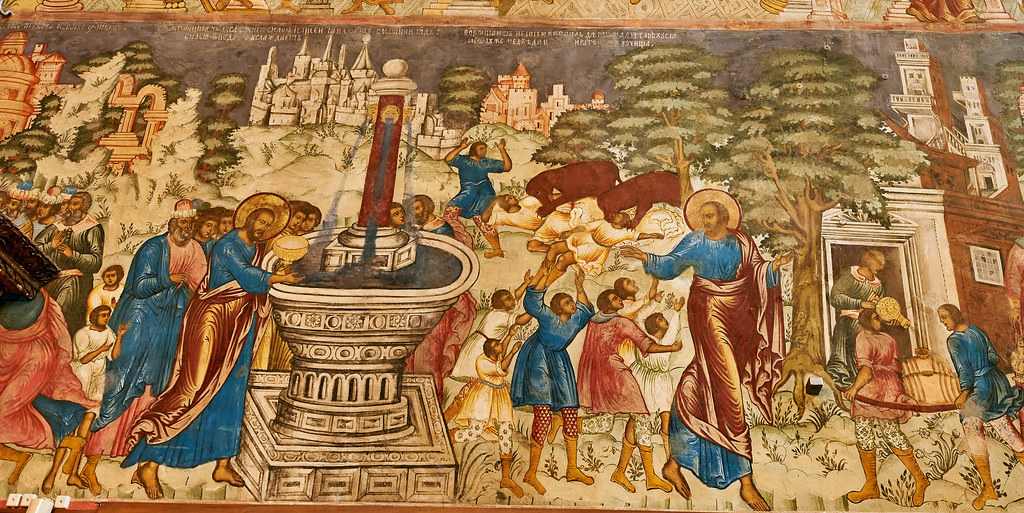
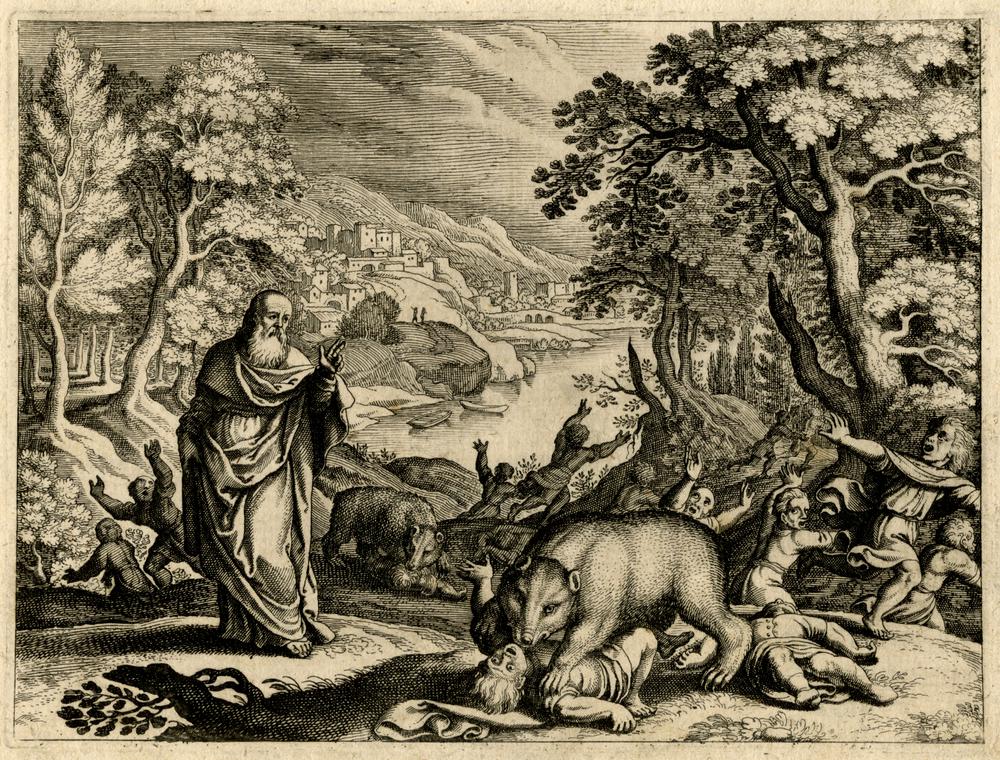
How did they know he was bald if he had a hat on?
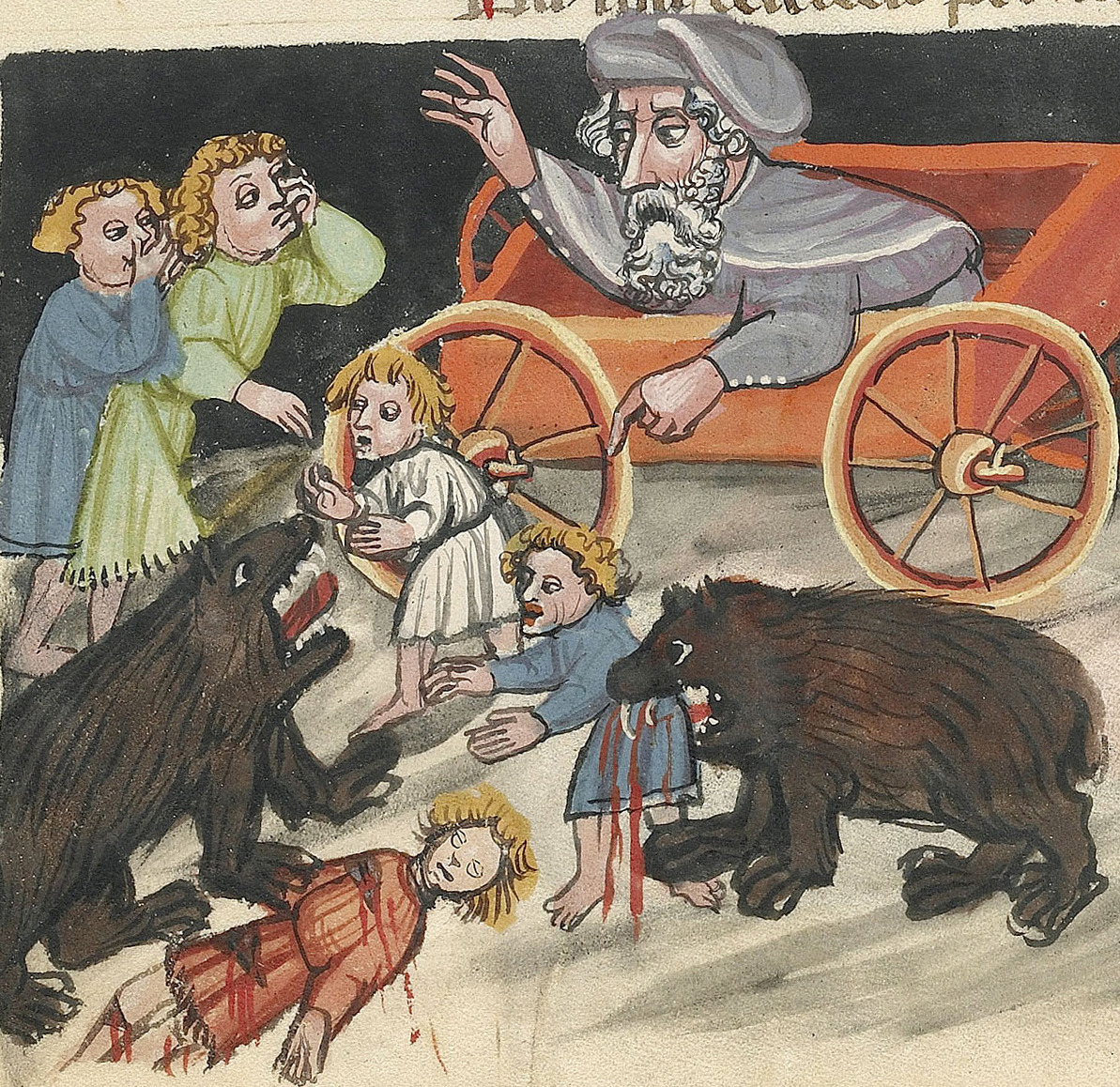
The Punishment of the Children who Mocked Elisha in Bethel; The Widow before Elisha; Unknown; Regensburg, Bavaria, Germany; about 1400 – 1410; Tempera colors, gold, silver paint, and ink on parchment; Leaf: 33.5 x 23.5 cm (13 3/16 x 9 1/4 in.); Ms. 33, fol. 229v




































Praesta, quaesumus, omnipotens Deus:
ut, sicut beatum Eliam Prophetam tuum et Patrem nostrum,
ante communem mortem,
curru igneo aereum elevasti ad caelum;
ita nos facias, eo interveniente, dum vivimus,
a terrenis semper ad caelestia spiritu sublevari,
et cum eo in resurrectione justorum pariter gaudere.
Per Dominum…
Credit: http://www.liturgialatina.org/carmelite/index.htm
I can’t bear it!!
Father, thank you for the reference to “Shadowplay,” which I will be very interested to read. A parallel which would seem to support Claire Asquith’s work on hidden Catholic references in Shakespeare is the body of modern musicological scholarship which has established the same pattern in the music of Shakespeare’s supreme musical contemporary William Byrd. Byrd remained a Catholic in Queen Elizabeth I’s Protestant England, and retired from the highest musical place in England to the obscurity of a country estate to write music for the liturgy, including the Propers for all the major feasts of the year (a feat few other great composers attempted). In both his choice of Biblical texts and his music, Byrd maintained a whole web of references to the truth of the Catholic faith. (For one of hundreds of examples, see his famous motet “Ave verum corpus,” in the first phrase of which he writes music that strikingly emphasizes “verum” rather than using the traditional emphasis on “corpus”.). Shakespeare was not alone in this regard.
Here are just two of many possible scholarly discussions of Byrd’s “hidden Catholic code.” (1) “William Byrd and the Catholics”, by Joseph Kerman (a renowned musicologist), in New York Review (a one-free-article subscription lets you read it): https://www.nybooks.com/articles/1979/05/17/william-byrd-and-the-catholics/. (2) “A Catholic Composer Who Risked Persecution” in The Christian Review: https://thechristianreview.com/a-catholic-composer-who-risked-persecution/
Geoffrey has provided the collect used by the Ancient Observance Carmelites for the prophet Elijah/Elias in the old Carmelite Rite. (It may be the same in the N.O.; I’ve never seen any of the Latin texts prescribed for the revised Carmelite propers. Assuming there are any.) The collect used by the Discalced Order, which used the Roman Rite, is somewhat different.
The collect for the prophet Eliseus was the same in both orders:
“Omnipotens sempiterne Deus, qui in electis Prophetis tuis mirabilis prædicaris : præsta, quæsumus ; ut sicut Eliæ spiritum in Propheta tuo Eliseo complevisti, ita in nobis Spiritus Sancti gratiam ad virtutum opera exercenda multiplicare digneris. Per Dominum . . . in unitate eiusdem. Amen.”
The old ICEL’s English looks like it’s probably based on that Latin text. You never know. A little dynamic equivalence goes a long way.
Side note: in my copy of the Carmelite propers dated 1993 the collect for Eliseus the prophet refers to “mankind”. I note that in the version you found that we’re now “the human family”.
Side note #2: The mantle in the original Carmelite habit was not white but striped. Not unusual in the Near East but when the brothers came to Western Europe the westerners often found it a bit weird. Hence the change. In the meantime, the stripes were said to symbolize the scorch marks left by the fiery chariot on Elias’s mantle as he tossed it to Eliseus as the chariot took him to heaven.
No deep meaning. I just like the story.
“Carmelites make much of St. Elisha, I suppose because of his connection to Elijah and that he sojourned on Mt. Carmel for a while.”
Elisha is considered, according to the “Liber de Institutione Primorum Monachorum,” written (c.1385) by Felip Ribot, to have been the successor to St. Elijah in ruling the monks of the Order. An excerpt from Copsey’s translation:
“Elisha ruled with the greatest diligence over the monks, sons of the prophets, who had been entrusted to him; he guided them, by his example and teaching, so that they might quickly reach the kingdom of God, and strive for perfection according to the pattern of the monastic lifegiven to Elijah by God.”
Copsey’s translation “The Ten Books on the Way of Life and the Great Deeds of the Carmelites” is, I think, worth reading. He doesn’t really take it as actual history in many places, but I think that he may be safely ignored. I have few doubts that there are, even if embellished, a number of facts preserved in the oral and supposed text traditions that the book is drawing upon.
Skipping along 306 years after the death of Shakespeare, we find that the Venerable English College started publishing a magazine, The Venerabile, in 1922, which has continued to the present, and scans of which are available online at the website of the Venerable English College – including, for instance, the World War II years during which the College was evacuated to England.